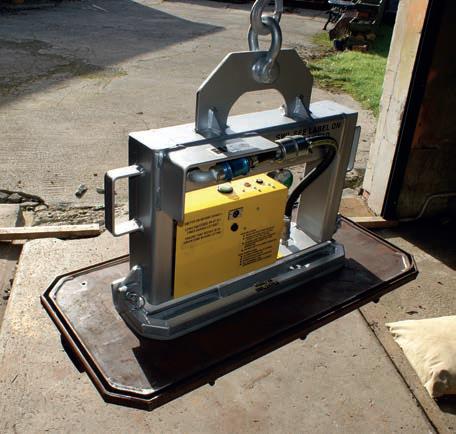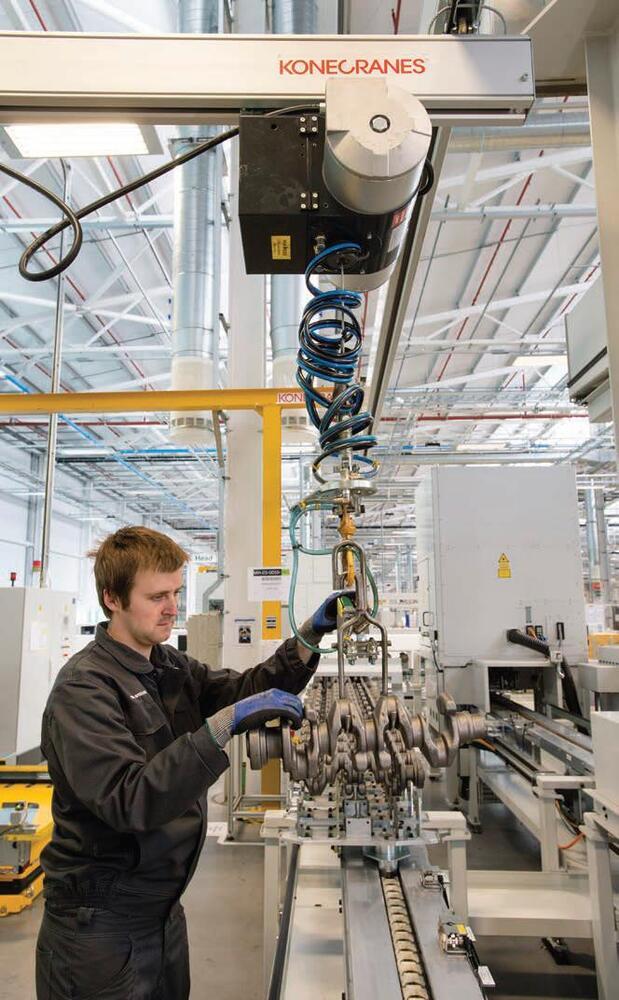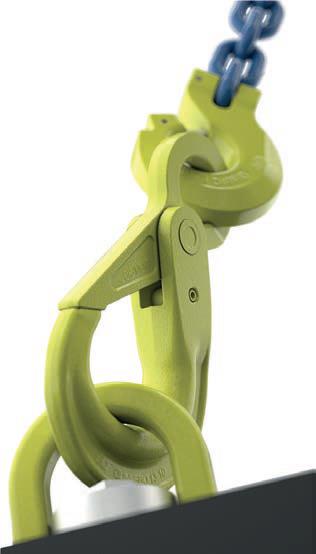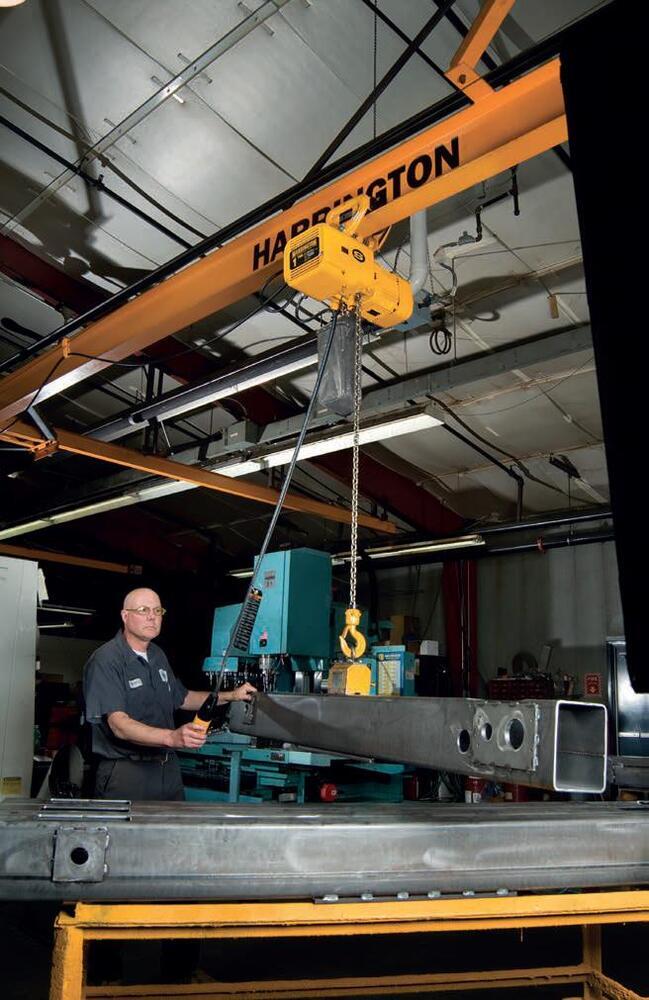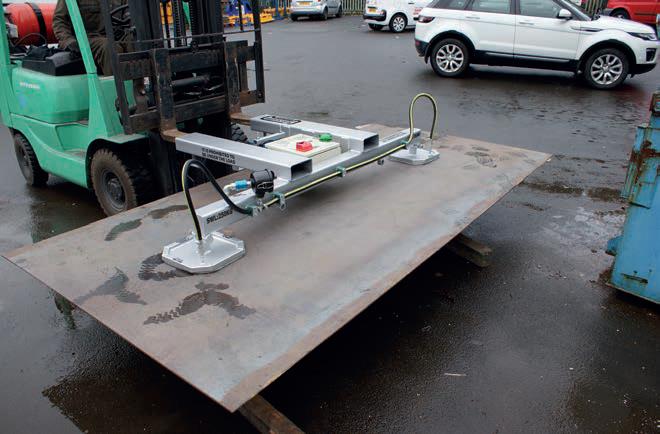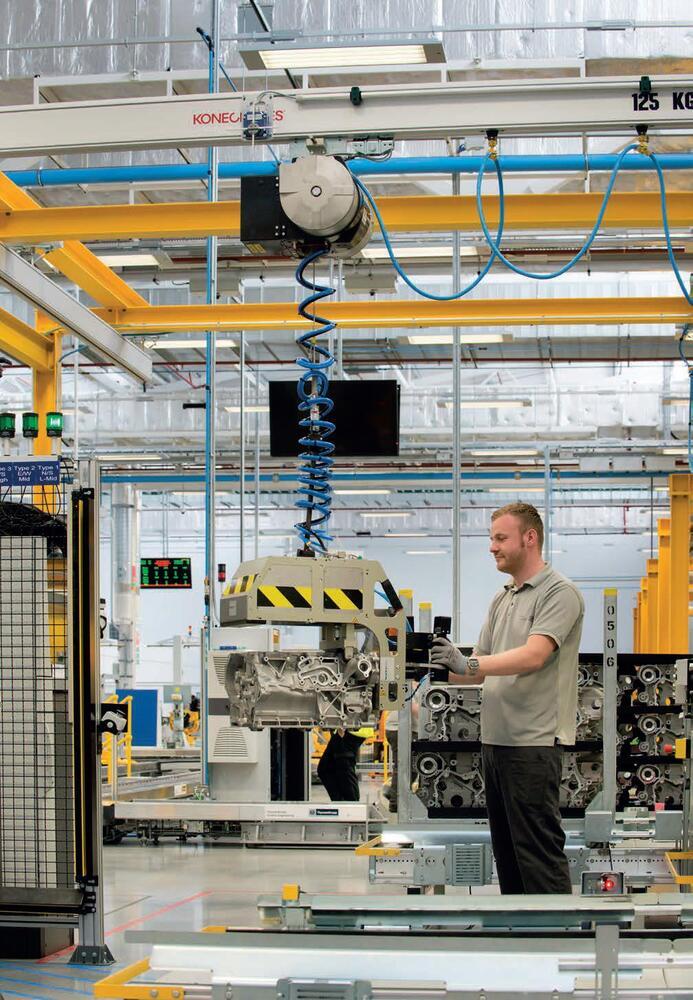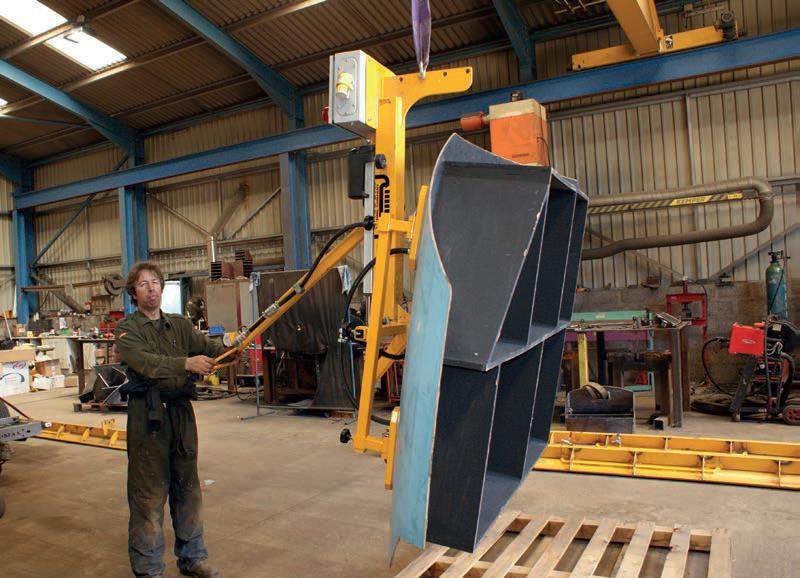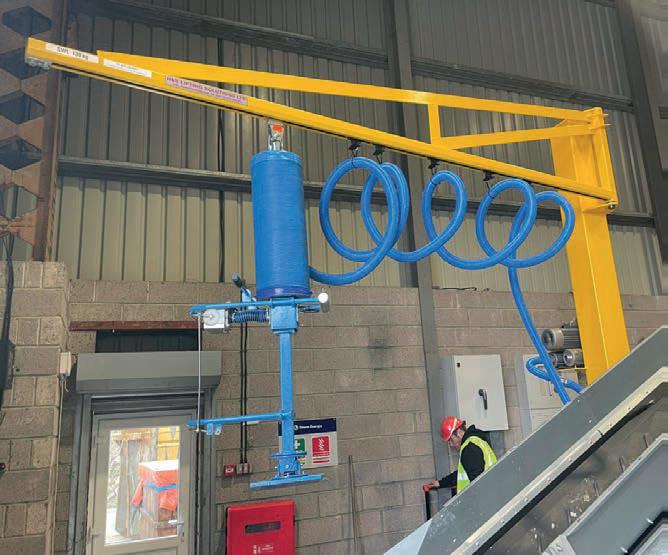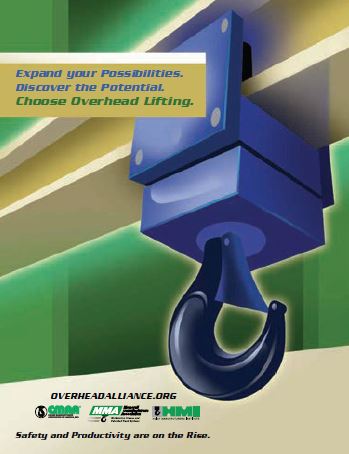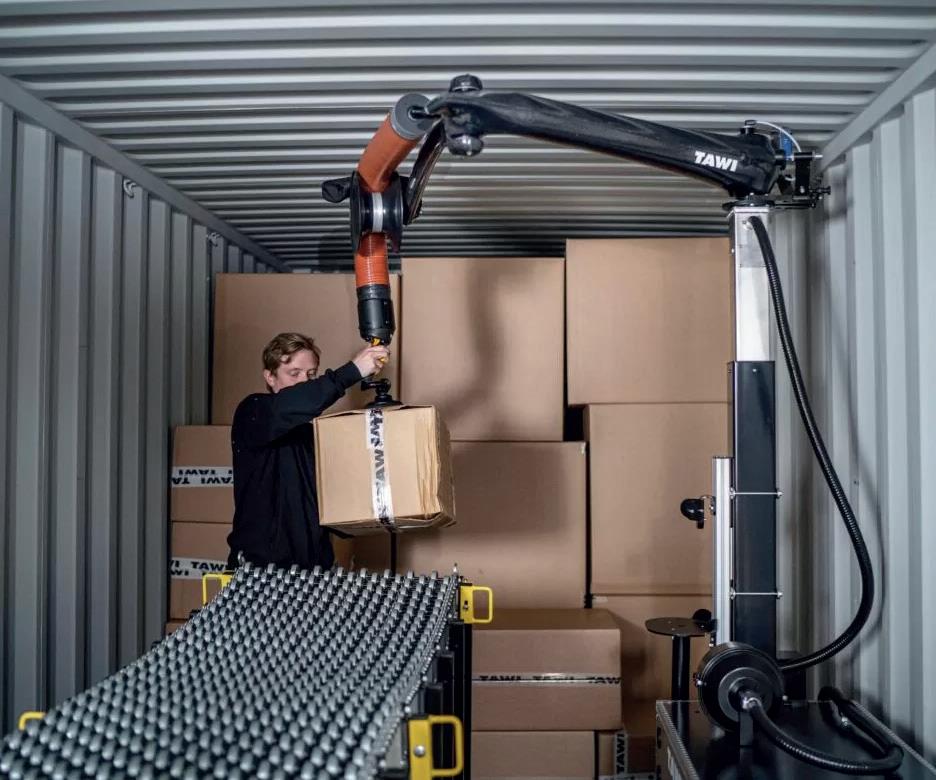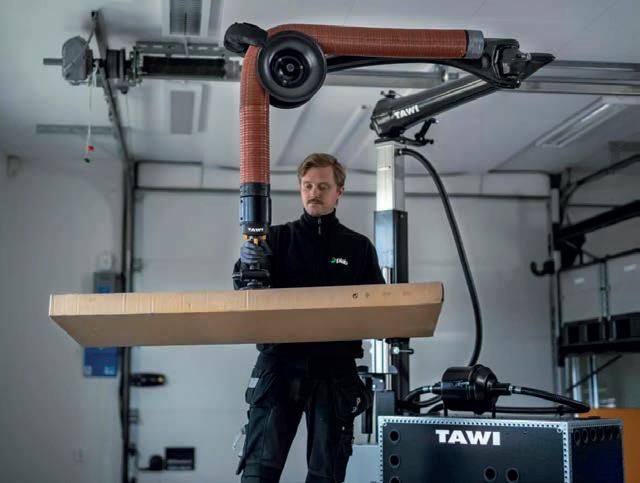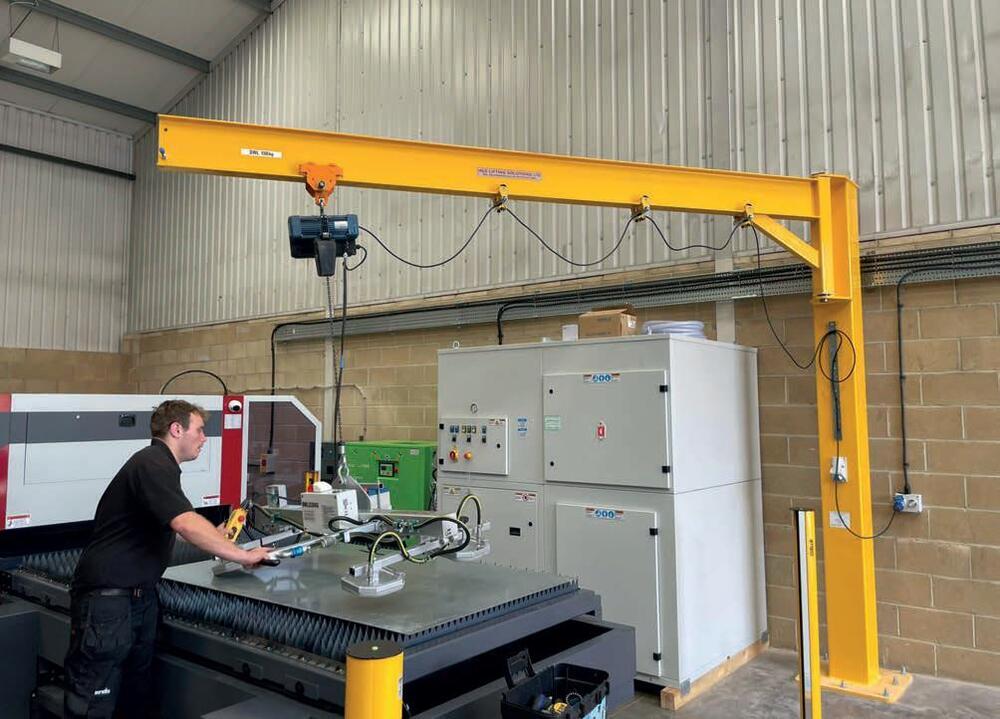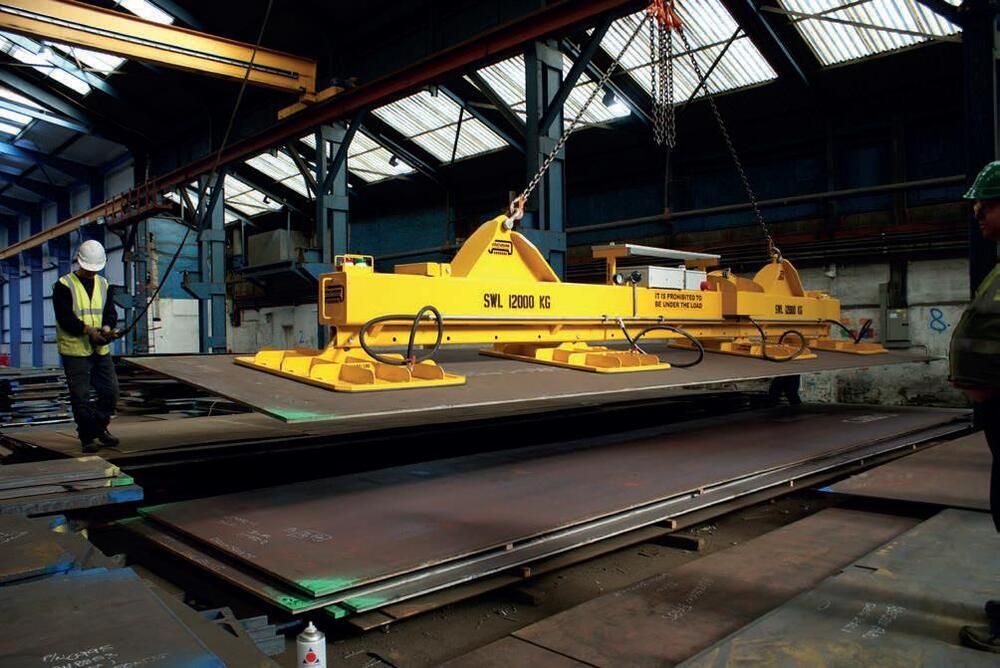A look at the latest in lifting attachments
5 July 2023Not every load can be hung from a hook – frequently, some kind of special attachment is needed. Julian Champkin reports.
A crane or hoist with a hook on the end seems a clear and simple solution to most lifting problems. But loads can be awkward things: very few of them, for example, have that convenient, and indeed necessary, hole on their upper side, exactly above their centre of gravity – the one that you need for your hook to have something to lift with. You can instead put slings around your load, which is not always easy, since the load before lifting is almost by definition resting on the ground, so how to you get your sling underneath it? Or you can use some powered below-the-hook device that grips the load from the side; or one that applies a vacuum and holds the load by pressure of air; or, simpler than these, if you are lucky, your load may be of a shape that will hold itself in place, by force of gravity, when some helpfully shaped and probably specially designed, passive and unpowered attachment is used instead of a hook.
Coils, reels and rolls are frequently encountered loads that simple hooks cannot easily handle: paper, roofing felt, metal coils of wire are examples – all of them basically cylindrical with a hole in the middle. Attachments that can handle them are of various designs. The standard design for lifting them is a C-hook, a horizontal prong – the bottom of the ‘C’ – that fits into the central hole of your coil; a suitable hole on the top edge of the ‘C’ allows the insertion of the cranes’ more traditionally shaped hook. Camlok, Bushman, Yaplex, Airpes and Britlift are just a few of the companies that supply them, off the shelf or made to order, in sizes and capacities that range from the small to the gigantic.
Flat plates can be lifted in a similar way, as long as they are reasonably rigid. Camlok, a British company based in Chester and part of Columbus Mckinnon, are the historical leaders here. The company, and the design, evolved from a general industrial need to lift and transfer steel plate either horizontally or vertically or in a combination of both. Some unknown genius at the company devised an ingenious ‘cam and jaw’ mechanism. The device slots onto the edge of the plate to be lifted. As the device is raised the weight of the plate pushes against a cam in the jaws of the device and in doing so, tightens it to positively clamp the plate into the device so it may be safely suspended and lifted. Hence the company name ‘Cam’ and ‘Lo(c)k’. Variations on the original principle have led to a vast spectrum of lifting clamps for other-shaped objects, from plate clamps via beam clamps, rail clamps and girder clamps to piling clamps and very many more.
The hoist and the lifting attachment are not always separable. The symbiosis between them has been shown rather clearly by the Crosby Group, a provider of below-the-hook lifting and rigging devices. In October, the group announced that it had completed debt financing for a tender offer to acquire outstanding shares of Kito Corporation, which, of course, is a major manufacturer of hoists – chain, electric and manual.
Gunnebo, Crosby Straightpoint, Crosby BlokCam, Crosby Airpes, ACCO, McKissick, Crosby Feubo, Trawlex, Lebus, Speedbinders, and CrosbyIP are just some of the below-the-hook brands of the Crosby Group. Kito brands include Kito itself, plus Harrington, Peerless, Jiangyin, Erikkila Van Leusden, Kito Weissenfels, SCC, and Fall Safe. In the UK, the Crosby Group, as of February this year, relocated to a larger, state-of-the-art facility for the production of its Crosby Straightpoint and Crosby BlokCam products. The production plant in Hampshire made a short trip inland to Waterlooville from Havant on England’s south coast. The expanded space provides additional capacity to meet the increasing demand for Crosby Straightpoint and Crosby BlokCam products as well as allow for future growth.
Elsewhere, Bushman Equipment, based in Menomonee Falls, Wisconsin, US, specialises in the design and manufacture of below-the-hook devices to grip, lift and transport almost any solid product. Its list includes C-hooks, coil grabs, coil lifters, vertical lifting equipment, spreader beams, hook blocks, ladle hooks, load weighing, sheet lifters, plate lifters, bundle lifters, pallet lifters, lifting tongs, roll handling equipment, drum tilters and rotating axis grabs (plus one or two more that we have probably missed). The company claims to maximise crane payloads because its devices are themselves of lower weight.
VACUUM LIFTING
Lifting by vacuum doesn’t sound terribly powerful. Paul Watson is sales director of the Vacuum Lifting Company, of East Kilbride in Scotland. He dispels any suggestion that vacuum lifting is for wimps and light loads only: “The biggest lifter we have done is for 40t capacity. That was for a construction project for Microsoft, lifting concrete segments.
“Vacuum lifting strength is all about area and it is an easy calculation: the greater the weight, the greater the area of suction you need. It can come from one large suction pad or several smaller ones.
“We use vacuums of around 40% [of air removed] for lifting,” he says. “The vacuum pumps are battery-powered, which means they are independent of mains supply and are portable: they can be used on construction sites and the like. It also makes them ideal attachments for forklift trucks; they greatly extend the type of loads they can lift and carry.
“Lifting concrete segments and steel plates are the most common applications. We make standard units, but can do bespoke designs as well. We have provided vacuum lifting for curved nuclear submarine fairings among other things.”
Some recent products include a triple pipe lifter, to lift three pipes at a time with capacities from 3.0t to 30t, which has been custom-designed for a client in the Philippines, who uses it for loading pipes into barges; the SP12KB single pad pipe lifter for stockyard gantry cranes, which can lift pipes up to 100in in diameter and up to 20t; and the TP30KB multi-pipe lifting system, which can lift up to three pipes at once using pads that can be adjusted in position or can be preset in position on a cross beam. They are radio-controlled – to free the load on set-down the appropriate button is pressed on the remote and the vacuum is released, which, of course, releases the load also.
The main requirement for vacuum lifting is that the load does not let air through it.
“Some thin concrete panels can be porous, so you would look at a different method for those,” says Watson. But porous loads in a factory or production-line process can be vacuum-lifted. “There you would use not suction cups but vacuum lifters,” he says. “It is a different technique. They use much more powerful pumps, and basically just keep sucking air in, through the load, all the time.”
In such machines the vacuum principle is cunningly extended. The vacuum keeps the load attached and in place, as with suction cups, but the same vacuum also does the actual lifting to the height that is required – no extra crane or hoist mechanism is needed. They are principally used in manufacturing: a flexible tube, attached to a suction pump, hangs down from some suitable support: think the hose and nozzle of a domestic vacuum cleaner hanging down from the ceiling. When the dangling end is placed on an object the suction pulls the load tightly against it, sealing the load in place. The suction then continues, forcing the tube itself to contract and shorten, pulling its end, and the attached load, into the air. It is a simple process; it requires only a single lever to control the lifting, gripping, lowering and releasing functions, and can typically be operated by just one worker. Loads of 80kg and upwards can be carried, and they need not be impervious to air. Porous surfaces, such as sacks and cardboard cartons, are by no means unusual loads.
H&S Lifting, based in Derbyshire, UK, makes such vacuum lifters. Pallets, reels and drums as well as metal plates and flat panels are all applications it has covered. The ever-increasing distribution and shipping sector, driven by the rise of internet shopping, is hugely dependent on boxes and cartons for transporting items, and poor manual handling can easily damage them. It can also damage the backs of the warehouse staff doing the lifting. There are therefore strong arguments for any such operation to install vacuum lifters.
Open, taped or strapped cartons can all be lifted. H&S can customise them with interchangeable suction feet and with different control handles for moving materials as required. The standard height of cartons that an ordinary vacuum lifter can lift, the company says, is 2.5m. However, up to 2.75m can be raised using optional telescopic control handles.
H&S Lifting Solutions recently designed, manufactured and installed a 100kg battery lifting system at a recycling plant. The project was to lift 100kg used battery packs from a bin and them place onto an inclined conveyor ready to be recycled. The dual handle concept of the vacuum lifter meant that the operator didn’t have to reach down into the bin when lifting the batteries. H&S designed a flexible joint on the vacuum lifter that enabled the product to be placed on the incline conveyor at the correct angle. This has made the handling of a very difficult product very easy and speedy – the client can now increase recycling throughput and at the same time eliminate manual handling.
An interesting advantage for vacuum lifters comes when they are used to lift paper or plastic sacks. The sack can be slit open while still being held in the air. So a sack of, say, flour can be lifted and positioned accurately over a bin, and can then be slit open and emptied with no loss of suction: the emptying bag remains suspended while the contents fall into the bin. This makes them particularly suited to cleanrooms for chemical and pharmaceutical industries or food processing environments.
AIR BALANCERS
Related but not identical are air balancers. Often used for fast pick-and-place operations on a production line, they use a distinctive ‘floating’ method to lift heavy loads and manoeuvre them with precision. Unlike normal hoists or vacuum lifters that incorporate up and down controls, air balancers use force sensors that detect the load weight and the up or down pressure of the operator’s hand (or finger) on the control lever – and from that they calculate the precise amount of upward or downward movement required to keep the load steady or to manoeuvre it up or down. The end result is that the load feels almost weightless to the operator, who can push or pull it horizontally, and move it up or down, with, literally, a fingertip, even if it weighs several kilos. It feels intuitive, but wonderfully light. Mechanical spring balancers are a type of air balancer lifting hoist ideal for short, vertical lifting. H&S can supply air balancers or spring balancers with a weight capacity of up to 165kg to bespoke or to standard designs.
Konecranes’ ATB AirBalancer has a lifting capacity of up to 350kg. Load weight compensation allows loads of varying weights to be lifted at the same speed, with predictable up and down control. It is available with an automatic load balancing feature, which makes it possible to lift up to 70kg in zero-gravity mode. Air balancers, say Konecranes, are ideal for the accurate load positioning that is required on assembly lines. This is especially true where the operator needs to use two hands on the load. For instance, if an operator is assembling two components horizontally, he or she needs to be able to guide the load with both hands to find the correct positioning to connect the two parts. This task would be nearly impossible if the load were on a chain hoist: one hand would be needed to operate the pendant control, leaving only the other one to guide the positioning. Balancers are said to be specifically programmed to make precise positioning easy.
Electric balancers, tend to handle lower capacities, of up to about 160kg, while air or pneumatic balancers can handle around twice that load.
Lifting Connect
Speaking at the Electra Mining conference, in Johannesburg, South Africa, last year, Khutso Mashile, operations manager, Yale Lifting Solutions, said the company wanted “to create intelligent motion that moves the world forward and improves lives”, writes Jenny Eagle.
It plans to do this by improving customer communication by offering a one-stop-shop for all lifting requirements to improve processes and grow the business to become a dominant player in the African market.
“Our main objective is to offer full solutions to all lifting requirements, not just offer the product. The company aims to focus on being solutions-driven and offer customers added-value with… an asset management system called Lifting Connect.”
Lifting Connect is a cloud tracking system that incorporates an ID to each asset, through tags, laser-engraved barcodes or RFID tags that are scannable using a specialised barcode reader or RFID scanner. This links to an android-based app that then allows for the input of asset-specific inspection information that is stored and downloadable into different formats (Excel, CSV, Print, PDF).
All records can be accessed online. The data is easily searchable and can be filtered according to your needs. The app enables users to add or create an asset, verify an asset, inspect, read, update or scan an asset, fill in generic or linked-to-asset forms, and issue and receive assets.
Describing Yale Lifting Solutions, Mashile said: “We offer after-sales services as well as repairs, spares and inspection of lifting equipment on-site at the convenience of the client. We also offer a special software and hardware that helps to control and manage lifting equipment, or any assets, effectively and efficiently. Our goods carry both local and international accreditation and proudly carry the South African Bureau of Standards mark.
“Pre-Covid, we restructured our business to be strong and stable, and enable growth. We increased our stock holding significantly during the unprecedented material supply constraints to ensure availability for
our customers.”
Improved efficiency
The US Material Handling, Logistics and Supply Chain Association (MHI) has published a report (pictured, right) on how overhead lifting and handling products can improve efficiency, productivity, safety and sustainability, writes Jenny Eagle.
“Many buyers make the mistake of considering only the initial investment when purchasing a lifting system, while not considering the best long-term life cycle investment. The wrong choice may incur further costs down the road,” says MHI report author Sara Specter. “By making the right choice that fits your specific lifting needs, you could very quickly make a better return on investment. Overhead lifting solutions offer a better return on investment than most other forms of lifting technologies. [They] often last for decades with a longer lifespan than most other lifting choices. They retain value because they are made from durable materials.”
Produced in partnership with the Crane Manufacturers Association of America (CMAA), the Monorail Manufacturers Association (MMA) and Hoist Manufacturers Institute (HMI), the report, called ‘Expand your Possibilities. Discover the Potential. Choose Overhead Lifting’, also discusses customised below-the-hook attachments.
From C hooks to mechanical and vacuum lifters, and from sheet and pallet lifters, and magnets and slings, to straps and drum turners, they enable a single overhead lifting system to accommodate a wide range of irregularly shaped, extremely heavy, or exceptionally fragile loads.
“If necessary, overhead lifting solutions can easily be reconfigured or converted and adapted to fit your changing needs,” says Specter. “In addition, many of today’s crane and hoist manufacturers can provide an assortment of below-the-hook attachments and end effectors for customised product handling. These attachments include items such as vacuum lifters, magnets and specialised tooling.”
Specter continues: “Many of today’s overhead solutions include: radio remote controls for handling product from a safe distance; advanced motor controls on all lifting and traversing motions for smooth starting and stopping to improve load positioning; overload limiting devices to prevent lifting damaging loads beyond rated capacity; ergonomic controls for precision lifting; material advancements in rope and chain to extend the life of the system and ensure safe operation for years to come; and advancements in electric motor technology that result in better equipment reliability and increased duty cycle.”
Lifting attachments legislation
Across Europe, the Lifting Equipment Engineers Association (Leea) is taking the lead within CEN, the European Committee for Standardisation, to rewrite standards EN 13155 (non-fixed load lifting attachments) and EN 13157 (hand-powered cranes), writes Jenny Eagle.
EN 13155 covers a variety of attachments, such as spreader beams and grabs but in its most recent report there were allegedly errors associated with test factors, which means it isn’t possible to design a compliant spreader beam. These errors have been fixed and the revised standard has been published.
According to Ben Dobbs, head, technical services, Leea, there are comparable problems with EN 13157, which covers manual lifting machines such as chain hoists and lever hoists. In a recent Leea webinar, Dobbs said the current version of the standard is an “acknowledged compromise which tried to accommodate varying practices across Europe”. As a result, not all of the essential health and safety issues are covered. There are also questions over the detail of verification techniques, suggesting these do not necessarily deliver repeatable results and the illustrations in the standard are poor, unrealistic and potentially misleading.
Also, the coverage of technology is over a decade out of date and fails to recognise changes in materials, products and manufacturing methods, especially since much of this equipment is now manufactured outside of Europe.
Mobile lifter
With a focus on vacuum lifters, Tawi USA has launched a Mobile High-Frequency Lifter (MHL) portable vacuum lifter designed to be used inside any ocean freight or box truck to reduce the manual lifting of materials during the loading or unloading process, writes Jenny Eagle.
The lifter enables a more flexible workforce by reducing the need to team lift heavy objects while minimising the opportunity for injury. It is claimed this is a faster, safer and easier material handling method when compared to individual or team lifting of materials by hand.
Capable of lifting materials up to 90lbs (40kg), Tawi’s MHL is comprised of a vacuum lifter integrated into a portable jib crane on a base plate. With its trigger-style controller, the operator can lift and move products without exerting any lifting force and at a faster rate than performed manually.
The MHL features a patented jib arm for low overhead spaces that is capable of horizontally gripping packages or materials to remove them from the top of a container or box truck. The unit is free-standing and powered by either a three-phase electrical or an optional battery pack for cordless mobility.
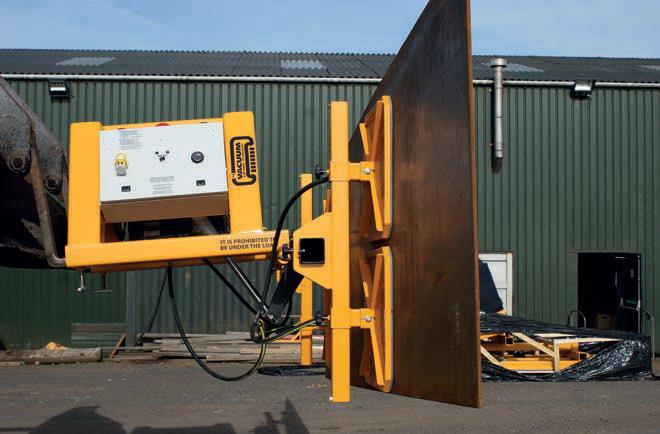 The Vacuum Lifting Company: “Vacuum lifting strength is all about area and it is an easy calculation: the greater the weight, the greater the area of suction you need.”
The Vacuum Lifting Company: “Vacuum lifting strength is all about area and it is an easy calculation: the greater the weight, the greater the area of suction you need.”
